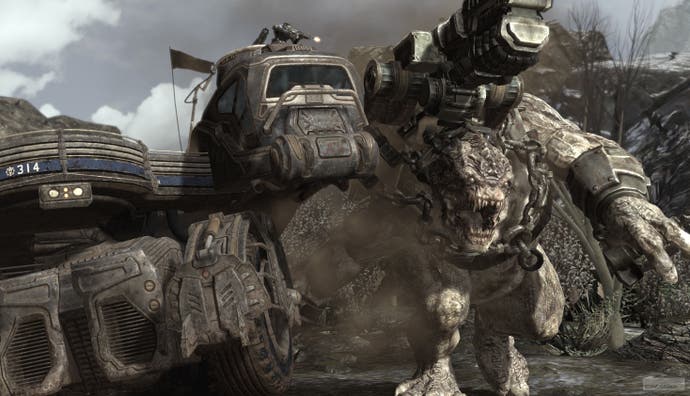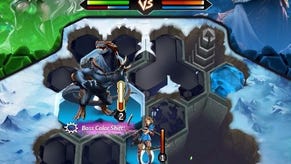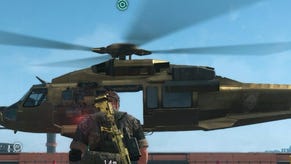Gears of War 2
Going underground.
It's an inventive approach that's echoed in the game's settings. Each of the five acts manages to be distinct, and yet consistent, with a broader colour palette, and a wider range of landscapes than the first game's. As it gets more experimental in its surroundings - and at least one level I'm not allowed to talk about is surprisingly experimental - its structure frees up as well. The first Gears could often fall into the trap of shunting you into a box and pouring in the enemies, before coaxing you into the next box and repeating the experience. This time the design is a bit bolder, allowing you lengthy periods where there's nothing at all to blast or chainsaw, and offering up the odd assault course, a simple puzzle, or even a chance to take in the scenery instead. These calculated low points turn out to be one of the game's best tricks, ratcheting up your anticipation until you're shooting at shadows; luring you deeper into its labyrinths before springing the trap. It's often easy to tell you're being softened up for a shock, but that doesn't make it any less effective.
As Gears 2 finds its feet in terms of pacing, the storytelling only benefits. Narrative may not have been a strength in the first game - it had a primitive tale to tell, and it did so in a confused manner - but with the sequel's twists and turns, a solid and intriguing yarn is emerging. And the link between story and level construction cannot be overstated: the gameplay variety eases you into the narrative, while the sombre mystery allows the designers to explore different kinds of gameplay, until, for one particularly effective section in the middle, Gears 2 barely resembles a shooter at all.
Yet even when the battles finally erupt, and even if its gunfights are more populated and intense overall, this is also a gloomier experience. Grim, menacing, and frequently subterranean, Gears 2 explores a darker world to the strangely cheerful hard-rock splatter of the original. It's still gorgeous to look at, covered with gloss and flaking rust and benefiting from some truly moody lighting, but Epic's beauty queen has taken on a harder edge. As the plot ambles towards its conclusion, the weight of the game's surroundings and the distinctly downbeat narrative are tangibly claustrophobic. Above all else, one of the biggest surprises is how uncomfortable it can make you feel, as story and setting come together to provide memorable moments in amongst the muzzle flashes and kerb-stomping.

Of course, as any veteran of late-night Gridlock sessions will know, the campaign was only half the experience with the first game, and Gears 2's multiplayer is equally excellent. The new maps tend to be more complex and multi-levelled, and as a result may take a bit longer for players to learn, but the fresh modes slot right in amongst the old favourites. Submission is a typically inventive take on Capture the Flag (the flag has a heartbeat - and gibs), and Wingman, where players partner up to take on other couples, is as close to deathmatch as Gears is ever likely to get, but with a tense, enduring interdependency that will probably end more than a few friendships.
The real star, however, is Horde, a ballistic assault on your worst score-rush tendencies that transforms maps into Gears-flavoured Mutant Storm: weapons spawn, then a wave of enemies hits, then more weapons and then another, tougher, wave. Although some maps are more suited to this than others - Day One's open-plan city intersection is particularly effective - Horde is a weighty slab of fun that can turn almost any of them into a time-sink, and the leaderboards are likely to be as compelling a reason to stick with Gears 2 as the levelling system has been for Call of Duty 4. Epic says it will monitor the game closely for exploits this time around (fair enough, we'll see), but we can confirm shotgun rolling is largely a thing of the past - incoming bullets now slow you down, and unless you're fighting somebody extremely stupid, you'll be dead before you're close enough to pull off any cheap tricks.

Like the original, on one level, Gears 2 is a brilliant advertisement for Unreal Engine 3, glorying in soft-body physics, glinting textures, and massive explosions. Even after a year of non-stop eye candy, Epic's series provides some of the most fiercely pretty visuals you'll get the chance to look at, even if its world is so charmingly ugly. Yet on another level, the game's a calling card from a developer that continues to mature in design as well as technology. The first game slowed down the crazy pace of Unreal Tournament - forcing you into using the environment every bit as much as the weapon-set - and the sequel continues to build on that with ease, but alongside the bare mechanics, Gears of War 2 shows a new interest in stories and varying the action. Best of all, it has the native intelligence to bring both aspects together.
















